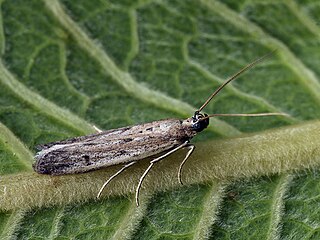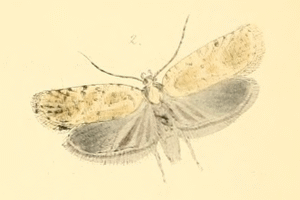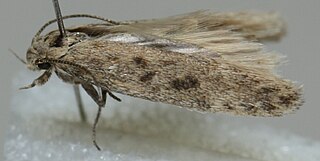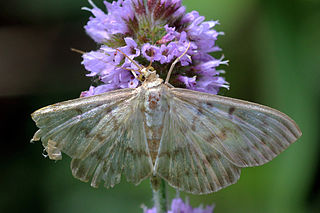
Mythimna albipuncta, the white-point, is a moth of the family Noctuidae. The species was first described by Michael Denis and Ignaz Schiffermüller in 1775. It is distributed throughout Europe and one subspecies is found in Tunisia. It is also found in Asia Minor, Armenia, and Iran, and the northeastern United States.

Cepphis advenaria, the little thorn, is a moth of the family Geometridae. The species can be found in Europe and across the Palearctic to Japan.

Thera variata, the spruce carpet, is a moth of the family Geometridae. It is found throughout Europe, North Asia and Japan. The common name spruce carpet is also used when referring to Thera britannica.

Orthosia populeti, the lead-coloured drab, is a moth of the family Noctuidae. It is found in Europe.

Hoplodrina blanda is a moth of the family Noctuidae. It is found in the Palearctic realm.

Pyrausta despicata, the straw-barred pearl, is a species of moth of the family Crambidae. It was described by Giovanni Antonio Scopoli in his 1763 Entomologia Carniolica.

Scoparia subfusca is a species of moth of the family Crambidae. It is found in Europe.

Falcaria lacertinaria, the scalloped hook-tip, is a moth of the family Drepanidae. The species was first described by Carl Linnaeus in his 1758 10th edition of Systema Naturae It is found in Europe and Anatolia then east to Eastern Siberia.

Anania fuscalis is a species of moth of the family Crambidae. It is found in Europe.

Homoeosoma nebulella, the Eurasian sunflower moth, is a moth of the family Pyralidae. It is found in Europe, Russia, Anatolia, the Middle East and West Africa. The wingspan is 20–27 mm.The forewings are pale whitish ochreous, tinged with grey and sprinkled with dark grey, towards costa suffused with whitish; first line indicated by two blackish dots, upper more remote from base; second faintly darker-edged, usually preceded by a dark fuscous subdorsal dot; two blackish transversely placed discal dots. The hindwings are subhyaline, fuscous-tinged, the veins and termen fuscous. Larva dull greenish-yellow dorsal and broader subdorsal lines dull purple; spiracular interrupted, double, dull purple; head brown: in flower-heads of Carduus
Brenthia pleiadopa is a species of moth of the family Choreutidae first described by Edward Meyrick in 1921. It is found in Magude, Mozambique.

Agonopterix nanatella is a moth of the family Depressariidae. It is found in most of Europe, except Fennoscandia, Poland, Ukraine, the Baltic region and most of the Balkan Peninsula.

Scrobipalpa obsoletella, the summer groundling, is a moth of the family Gelechiidae. It is found in most of Europe, Turkey, the Caucasus, from Iran to Asian Russia (Transbaikal) and Mongolia. It has also been recorded from New Zealand, South Africa and North America, where it is probably an introduced species. The habitat consists of coastal salt marshes and sandy beaches.

Patania ruralis, the mother of pearl moth, is a species of moth in the family Crambidae. It was described by Giovanni Antonio Scopoli in 1763. It is found in Europe.

Scrobipalpa instabilella, the saltern groundling, is a moth in the family Gelechiidae. It was described by John William Douglas in 1846. It is found in on the Canary Islands, in Algeria, Ireland, Great Britain, Portugal, Spain, France, Belgium, the Netherlands, Germany, Denmark, Italy, Sardinia, Sicily, Greece, Cyprus and Palestine. It is also present in the United States, where it has been recorded from California.
Battaristis orthocampta is a moth of the family Gelechiidae. It was described by Edward Meyrick in 1914. It is found in Guyana.
Compsolechia thysanora is a moth of the family Gelechiidae. It was described by Edward Meyrick in 1914. It is found in Peru.
Stenoma cana is a moth of the family Depressariidae. It is found in Brazil (Amazonas), Peru and French Guiana.
Mothonica fluminata is a moth of the family Depressariidae. It is found in Colombia and Suriname.
Gonionota isastra is a moth in the family Depressariidae. It was described by Edward Meyrick in 1926. It is found in Colombia.















